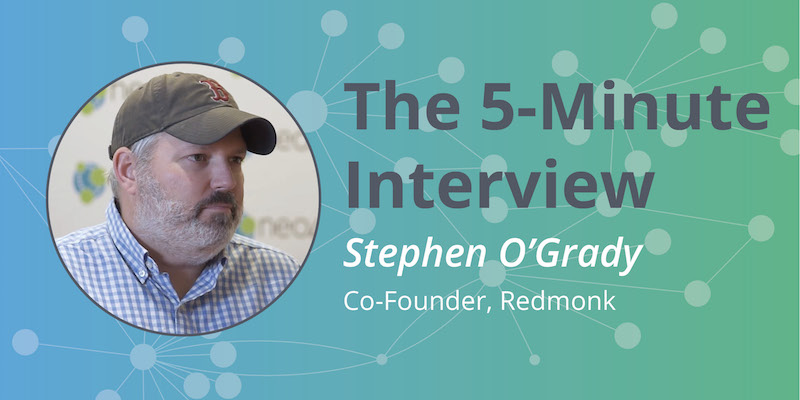When deciding what projects to take on, developers should consider the broader context and the implications of what they’re being asked to build. So says Stephen O’Grady from Redmonk, a developer-focused industry analyst firm that tracks, among other things, the top 20 programming languages over time.
In this week’s five-minute interview (conducted at GraphConnect 2018 in NYC), Stephen O’Grady shared his view of the use cases and future of graph technology.
Where do you think graphs fit into the wider tech ecosystem?
O’Grady: I think the interesting thing for me with graph is that it is one of a number of different non-relational technologies that have emerged over the last decade or so. For decades we had relational databases and then we split them off. We have all sorts of specialized data storage now.
It makes sense because it’s a different-tools-for-different-jobs approach. Graph in particular is valuable because it allows us to do different things with different problems, in the sense that it traverses, well, obviously, graphs and it can do so much more quickly than the relational technologies that preceded it.
The use cases for graphs are pretty varied. You’ve heard talk today of everything from delivery routing to social graph traversal to Internet of Things (IoT) use cases. Really anywhere there is a preponderance of entities, wherever they might be, and relationships between those entities that need to be analyzed for any purpose, a graph database is a pretty good fit.
Do you see a symbiotic relationship between graphs and other technologies?
O’Grady: Yes, and one of the ones that comes to mind is artificial intelligence. Hillary Mason, who gave the keynote today, has done things like machine learning and deep learning and applied these sort of techniques and approaches to a variety of data problems.
To me there is a natural fit in the sense that some of the datasets that are going to feed these machine learning systems are going to be graph in nature, and therefore being able to traverse them, being able to process them, and having integration points between the two systems, I think will be incredible.
Where do you see the future of graph technology going?
O’Grady: From my perspective, graph technology needs to go mainstream. Because although it’s been a very useful tool for quite some time now, it has still been a specialized and, in many cases, a niche tool. What we want essentially is to get to a point where everybody understands that graph is a real and important technology, and that it is something that people can pick up and analyze much in the way that they would with a relational database today.
What is the biggest takeaway from your GraphConnect keynote?
O’Grady: I think that the biggest takeaway from my keynote is that developers, practitioners, and data scientists all need to take a step back and think about what we’re building, and, more importantly, why we’re building it.
There’s been a history in this industry of people just building things, either because it’s interesting or because they were instructed to, and some of the things that we have built have been damaging at times, even potentially dangerous.
The idea is essentially to try to get developers to be more conscious of the wider context in terms of what they build and what they’re being asked to build, both for ethical reasons, but also for purposes that are much more self-interested such as for their own career and for their own earning potential. If there’s one thing that I hope they all take away, it’s to always ask the question “why?”
Want to share about your Neo4j project in a future 5-Minute Interview? Drop us a line at content@neo4j.com
Download this white paper, The Top 5 Use Cases of Graph Databases, and discover how to tap into the power of graphs for the connected enterprise.
Read the White Paper




